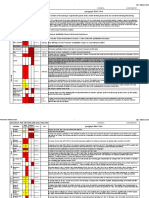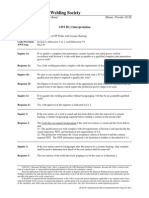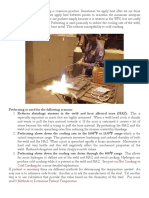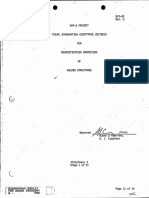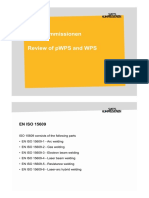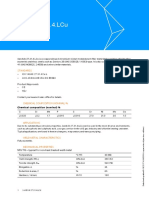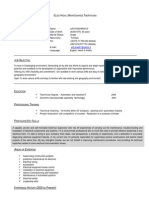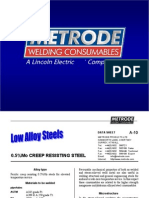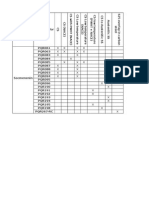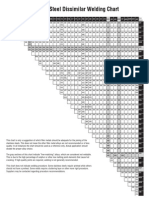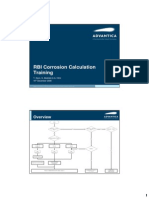Overlay (Required Tests)
Overlay (Required Tests)
Uploaded by
laz_kCopyright:
Available Formats
Overlay (Required Tests)
Overlay (Required Tests)
Uploaded by
laz_kOriginal Title
Copyright
Available Formats
Share this document
Did you find this document useful?
Is this content inappropriate?
Copyright:
Available Formats
Overlay (Required Tests)
Overlay (Required Tests)
Uploaded by
laz_kCopyright:
Available Formats
2011a SECTION IX
QW-453
PROCEDURE/PERFORMANCE QUALIFICATION THICKNESS LIMITS AND TEST
SPECIMENS FOR HARD-FACING (WEAR-RESISTANT) AND CORROSION-
RESISTANT OVERLAYS
Corrosion-Resistant Overlay Hard-facing Overlay (Wear-Resistant)
[Note (l)] [Note (2)]
Thickness of Test Nominal Base Metal
I
Type and Number of Nominal Base Metal
I
Type and Number
Coupon (T) Thickness Qualified ( T) Tests Required Thickness Qualified (T) of Tests Required
Procedure Qualification
Testing
Less than 1 in. (25 mm) T T qualified to unlimited
1
T qualified up to 1 in.
)
1 in. (25 mm) and over T
1 in. (25 mm)
Notes (4), (5), and (9)
(25 mm)
Notes (3), (7), (8), and (9)
to unlimited 1 in. (25 mm) to
unlimited
Performance
Qualification
Testing
Less than 1 in. (25 mm) T T qualified to unlimited
1
T qualified to unlimited
1
1 in. (25 mm)
Note (6)
1 in. (25 mm)
Notes (8) and (IO)
1 in. (25 mm) and over T
to unlimited to unlimited
NOTES:
(1) The qualification test coupon shall consist of base metal not less than 6 in. (150 mm) x 6 in. (ISO mml. The weld overlay cladding shall be
a minimum of 1 Yz in. (38 mm) wide by approximately 6 in. (ISO mm) long. For qualification on pipe, the pipe length shall be a minimum
of 6 in. (150 mm), and a minimum diameter to allow the required number of test specimens. The weld overlay shall be continuous around
the circumference of the test coupon. For processes (performance qualification only) depositing a weld bead width greater than Yz in. (13 mm)
wide, the weld overlay shall consist of a minimum of three weld beads in the first layer.
(2) The test base metal coupon shall have minimum dimensions of 6 in. (150 mm) wide x approximately 6 in. (150 mm) long with a hard-faced
layer a minimum of 1 Yz in. (38 mm) wide x 6 in. (ISO mm) long. The minimum hard-faced thickness shall be as specified in the Welding
Procedure SpeCification. Alternatively, the qualification may be performed on a test base metal coupon that represents the size of the production
part. For qualification on pipe, the pipe length shall be 6 in. (ISO mm) minimum, and of a minimum diameter to allow the required number
of test specimens. The weld overlay shall be continuous around the circumference of the test coupon.
(3) The hard-facing surface shall be examined by the liquid penetrant method and shall meet the acceptance standards in QW-195.2 or as specified
in the WPS. Surface conditioning prior to liquid penetrant examination is permitted.
(4) The corrosion-resistant surface shall be examined by the liquid penetrant method and shall meet the acceptance standards as specified in QW-195.
(5) Following the liquid penetrant examination, four guided side-bend tests shall be made from the test coupon in accordance with QW-161. The
test specimens shall be cut so that there are either two specimens parallel and two specimens perpendicular to the direction of the welding,
or four specimens perpendicular to the direction of the welding. For coupons that are less than in. (10 mm) thick, the width of the side-
bend specimens may be reduced to the thickness of the test coupon. The side-bend specimens shall be removed from locations specified in
QW-462.S(c) or QW-462.5(d).
(6) The test coupon shall be sectioned to make side-bend test specimens perpendicular to the direction of the welding in accordance with QW-161.
Test specimens shall be removed at locations specified in QW-462.S(c) or QW-462.S(d).
(7) After surface conditioning to the minimum thickness specified in the WPS, a minimum of three hardness readings shall be made on each of
the specimens from the locations shown in QW-462.S(b) or QW-462.5(e). All readings shall meet the requirements of the WPS.
(8) The base metal shall be sectioned transversely to the direction of the hard-facing overlay. The two faces of the hard-facing exposed by sectioning
shall be polished and etched with a suitable etchant and shall be visually examined with x 5 magnification for cracks in the base metal or the
heat-affected zone, lack of fusion, or other linear defects. The overlay and the base metal shall meet the requirements specified in the WPS.
All exposed faces shall be examined. See QW-462.S(b) for pipe and QW-462.5(e) for plate.
(9) When a chemical composition is specified in the WPS, chemical analysis specimens shall be removed at locations specified in QW-462.5(b)
or QW-462.5(el. The chemical analysis shall be performed in accordance with QW-462.5(a) and shall be within the range specified in the
WPS. This chemical analysis is not required when a chemical composition is not specified on the WPS.
(10) At a thickness greater than or equal to the minimum thickness specified in the WPS, the weld surface shall be examined by the liquid
penetrant method and shall meet the acceptance standards in QW-195.2 or as specified in the WPS. Surface conditioning prior to liquid
penetrant examination is permitted.
151
You might also like
- Welded Steel Pipe Design ManualDocument93 pagesWelded Steel Pipe Design ManualfileseekerNo ratings yet
- Electrical Maintenance Supervisor CVDocument3 pagesElectrical Maintenance Supervisor CVlaz_k100% (3)
- Welding Procedure Specification (WPS) : Joint Design PositionDocument9 pagesWelding Procedure Specification (WPS) : Joint Design PositionpetermanroelibraryNo ratings yet
- Asset Integrity EngineerDocument4 pagesAsset Integrity Engineerlaz_kNo ratings yet
- Preheat and Interpass TempDocument2 pagesPreheat and Interpass TempUche UrchNo ratings yet
- ASME Section IX Welding Procedure Qualification: Antonius P. BramonoDocument50 pagesASME Section IX Welding Procedure Qualification: Antonius P. BramonoHAKANNo ratings yet
- QW-482 Suggested Format For Welding ProcDocument2 pagesQW-482 Suggested Format For Welding Procsachin0% (1)
- Why Preheating & Interpass Temperature RequiredDocument4 pagesWhy Preheating & Interpass Temperature RequiredMohammad RizwanNo ratings yet
- WPS & PQR & WPQDocument26 pagesWPS & PQR & WPQrakanalammari505No ratings yet
- 5.Exhibit-5.Technical Delivery Conditions-Welding ConsumablesDocument1 page5.Exhibit-5.Technical Delivery Conditions-Welding Consumablesjohn gonzalezNo ratings yet
- TDC-10A Rev 3 Upgradation by Welding of C12A Steel CastingsDocument3 pagesTDC-10A Rev 3 Upgradation by Welding of C12A Steel CastingsGohilakrishnan ThiagarajanNo ratings yet
- Variables For Wps/Welder Qualification Variable WPS Welder: ParagDocument2 pagesVariables For Wps/Welder Qualification Variable WPS Welder: Paragahmed sobhyNo ratings yet
- GMAWDocument12 pagesGMAWsushant47100% (1)
- AWS D1.1 GuidesDocument7 pagesAWS D1.1 GuidesMuhammad FakhriNo ratings yet
- Calculate Weld Metal VolumeDocument7 pagesCalculate Weld Metal VolumeChris De La Torre0% (1)
- ASME Welding PositionsDocument3 pagesASME Welding PositionsMicheal Murphy100% (1)
- Category of RadiographyDocument9 pagesCategory of RadiographySAGARNo ratings yet
- Weld Map Pressure VesselDocument32 pagesWeld Map Pressure Vesselarun yNo ratings yet
- Fcaw NC IiDocument60 pagesFcaw NC IiDick Mijares UndagNo ratings yet
- 4 - PREPARATION OF WPS - StudentDocument22 pages4 - PREPARATION OF WPS - Studentrazlan ghazaliNo ratings yet
- Piping WPS SMAWDocument2 pagesPiping WPS SMAWJk KarthikNo ratings yet
- Full Thickness Repair Welding Welding Procedure Specification (WPS) in Accordance With API 1104 21: 2016Document6 pagesFull Thickness Repair Welding Welding Procedure Specification (WPS) in Accordance With API 1104 21: 2016Juni Kurniyanto100% (1)
- Basic Points of P91Document4 pagesBasic Points of P91Asad Bin Ala Qatari100% (1)
- Asme Ix Welder Qualification Interpretation PDFDocument95 pagesAsme Ix Welder Qualification Interpretation PDFnizam1372No ratings yet
- Weld Repair After PWHT ASME Sec VIII Div.1Document6 pagesWeld Repair After PWHT ASME Sec VIII Div.1GesNo ratings yet
- HFY-PIP-SP-00004 X Specification For Sour Service - A-CommentedDocument9 pagesHFY-PIP-SP-00004 X Specification For Sour Service - A-CommentedVignesh PanchabakesanNo ratings yet
- Mechanical Testing Requirement As Per ASME BPVC Section IXDocument6 pagesMechanical Testing Requirement As Per ASME BPVC Section IXHary adiNo ratings yet
- WPS - 006Document13 pagesWPS - 006MAT-LIONNo ratings yet
- PWHT, HT, Igc, MawpDocument40 pagesPWHT, HT, Igc, Mawpsachinshirnath100% (1)
- Flange Bolt Torque Sequence and Torque Table - A Complete Bolt Tightening ProcedureDocument16 pagesFlange Bolt Torque Sequence and Torque Table - A Complete Bolt Tightening Procedureal arabiNo ratings yet
- 10 Procedure For PWHTDocument5 pages10 Procedure For PWHTSachin S. SalunkheNo ratings yet
- Code Cases AWS D1.1Document2 pagesCode Cases AWS D1.1rginunes9044No ratings yet
- Duplex Welding GuidelinesDocument13 pagesDuplex Welding GuidelinesadelNo ratings yet
- QC TolaranceDocument35 pagesQC TolaranceRajkumar A100% (1)
- WPS PQR CompressedDocument5 pagesWPS PQR CompressedBalaje MantravadiNo ratings yet
- Magnetic Particle Examination of WeldsDocument4 pagesMagnetic Particle Examination of WeldsshruthiNo ratings yet
- Module 9.qualification 1.welding PerformanceDocument6 pagesModule 9.qualification 1.welding PerformanceMohd Nizam100% (1)
- Weld Fit Up Inspection Employee TrainingDocument10 pagesWeld Fit Up Inspection Employee TrainingBadiuzzama Azmi100% (2)
- P91 ProfileDocument6 pagesP91 ProfilesrinivasanNo ratings yet
- Review of GTAW Welding ParametersDocument14 pagesReview of GTAW Welding Parameterskervyn SáenzNo ratings yet
- Prequalified Welding Procedure Spesification (WPSS) : (Semiautomatics, Mechanized, Etc)Document2 pagesPrequalified Welding Procedure Spesification (WPSS) : (Semiautomatics, Mechanized, Etc)Nuril VS theWorldNo ratings yet
- Why Is Preheating NecessaryDocument3 pagesWhy Is Preheating NecessaryahmedNo ratings yet
- D1.5M D1.5 2015 AMD1 Form O 2 FillableDocument1 pageD1.5M D1.5 2015 AMD1 Form O 2 Fillablevikasphopale1No ratings yet
- WPS - 021Document13 pagesWPS - 021MAT-LIONNo ratings yet
- Shell Petroleum Development Company: (Implemented/Issued For Review/Complete)Document17 pagesShell Petroleum Development Company: (Implemented/Issued For Review/Complete)Siva RamNo ratings yet
- VT Acceptance Criteria WeldsDocument14 pagesVT Acceptance Criteria WeldsCharwin Xiao100% (2)
- Asme Boiler and Pressure Vessel Codes: SectionsDocument68 pagesAsme Boiler and Pressure Vessel Codes: Sectionsajay thomasNo ratings yet
- Qualification of Procedure and Welder (19 February 2014)Document20 pagesQualification of Procedure and Welder (19 February 2014)Zanuardi YahyaNo ratings yet
- BPQ REV. 0 Interactive FormDocument2 pagesBPQ REV. 0 Interactive FormcosmicbunnyNo ratings yet
- IRN - 18.07.2019 - Harshad Panchal - Revision-0 - Furnace Fabrica - JNK - PORVAIR - RIL PDFDocument3 pagesIRN - 18.07.2019 - Harshad Panchal - Revision-0 - Furnace Fabrica - JNK - PORVAIR - RIL PDFsaptarshi jashNo ratings yet
- Asme 9 TipsDocument13 pagesAsme 9 Tipsnasrpk100% (1)
- Part 02 - Review of PWPS and WPSDocument9 pagesPart 02 - Review of PWPS and WPSYan FerizalNo ratings yet
- ABout Preheat Before WeldingDocument2 pagesABout Preheat Before WeldingHary Olya AdriansyahNo ratings yet
- Tube-To-Tube Sheet Joint RequirementsDocument2 pagesTube-To-Tube Sheet Joint RequirementsWaqas WaqasNo ratings yet
- Company Name Key Information Questions Answers File Reference Reviews & ApprovalsDocument7 pagesCompany Name Key Information Questions Answers File Reference Reviews & ApprovalsMAT-LIONNo ratings yet
- Visual Inspection Report-BaiturDocument5 pagesVisual Inspection Report-BaiturBlusukan negeri100% (1)
- WM PWHTDocument18 pagesWM PWHTFaiz Ishak100% (1)
- Fracture TestDocument1 pageFracture TestYuvaraj SathishNo ratings yet
- WPS FGPDocument1 pageWPS FGPShabbir HussainNo ratings yet
- Heat TreatmentDocument5 pagesHeat TreatmentsheikmoinNo ratings yet
- B. Importance of Preheat, Interpass, DHT, Isr, PWHTDocument19 pagesB. Importance of Preheat, Interpass, DHT, Isr, PWHTJay ShahNo ratings yet
- Challenges in Corrosion: Costs, Causes, Consequences, and ControlFrom EverandChallenges in Corrosion: Costs, Causes, Consequences, and ControlNo ratings yet
- Datasheet-Sandvik-27-31-4-Lcu-En-V2017-09-19 16 - 34 Version 1Document3 pagesDatasheet-Sandvik-27-31-4-Lcu-En-V2017-09-19 16 - 34 Version 1laz_kNo ratings yet
- Chem Iii-Amines-P255 JOB DescriptionDocument1 pageChem Iii-Amines-P255 JOB Descriptionlaz_kNo ratings yet
- Socket Weld LeakDocument5 pagesSocket Weld Leaklaz_k100% (1)
- Datasheet-Sandvik-27-31-4-Lcu-En-V2017-09-19 16 - 34 Version 1Document3 pagesDatasheet-Sandvik-27-31-4-Lcu-En-V2017-09-19 16 - 34 Version 1laz_kNo ratings yet
- Trade of Vehicle Body Repair: MIG - Welding FabricationDocument149 pagesTrade of Vehicle Body Repair: MIG - Welding Fabricationlaz_kNo ratings yet
- PWHT Responsibility Assignment Matrix: SR Topic Tasks DetailsDocument6 pagesPWHT Responsibility Assignment Matrix: SR Topic Tasks Detailslaz_kNo ratings yet
- Bonney Forge BrochureDocument22 pagesBonney Forge BrochureAnonymous dvrhf5No ratings yet
- Carber Service CatalogDocument32 pagesCarber Service Cataloglaz_kNo ratings yet
- Electrical Maintenance TechniciancvDocument3 pagesElectrical Maintenance Techniciancvlaz_k100% (1)
- Metrode ConsumablesDocument309 pagesMetrode Consumablesrodofgod100% (1)
- Personnel, Consumable & ToolsDocument3 pagesPersonnel, Consumable & Toolslaz_kNo ratings yet
- Pipe LineDocument62 pagesPipe LineBahtiar Anak LaNang100% (1)
- AIChE Wilhelm April 08 Process SafetyDocument16 pagesAIChE Wilhelm April 08 Process Safetymostafa_1000No ratings yet
- EN 1090 White Paper17 119019 PDFDocument24 pagesEN 1090 White Paper17 119019 PDFZaza PokumbaNo ratings yet
- Portfolio Storage&Drying Control ProcedureDocument4 pagesPortfolio Storage&Drying Control Procedurelaz_kNo ratings yet
- Offshore ProtectionDocument334 pagesOffshore ProtectionSumit PardeshiNo ratings yet
- Stainless Steel Dissimilar Welding ChartDocument1 pageStainless Steel Dissimilar Welding Chartlaz_kNo ratings yet
- Bicine - AmineDocument14 pagesBicine - Aminelaz_kNo ratings yet
- Weld Filler WireDocument37 pagesWeld Filler WireSiva Raman MurugesanNo ratings yet
- RBI Corrosion Calculation Day2Document7 pagesRBI Corrosion Calculation Day2laz_kNo ratings yet
- Mep-01.02 Detail Dock ShelterDocument1 pageMep-01.02 Detail Dock ShelterTri MurwantoNo ratings yet
- Comparative Analysis of B.P. 220, P.D. 1096, P.D. 957 and Fire CodeDocument8 pagesComparative Analysis of B.P. 220, P.D. 1096, P.D. 957 and Fire CodeyllaNo ratings yet
- Transportation EngineeringDocument3 pagesTransportation EngineeringSiti nurainNo ratings yet
- Karoshoek Solar One (Pty) LTDDocument14 pagesKaroshoek Solar One (Pty) LTDpthakur234100% (1)
- The Havelis: of HadautiDocument4 pagesThe Havelis: of HadautidudedeepNo ratings yet
- Floor Plan Front Elevation Typical Side Elevation: Cebu-Cordova Link Expressway ProjectDocument1 pageFloor Plan Front Elevation Typical Side Elevation: Cebu-Cordova Link Expressway ProjecteddieNo ratings yet
- CLORIOUS - Control ValvesDocument4 pagesCLORIOUS - Control ValvesRM HaroonNo ratings yet
- Regua de FittingsDocument3 pagesRegua de FittingsBruno GazzaneoNo ratings yet
- Technical Data Sheet Clad Steel Wire 3.78 MMDocument1 pageTechnical Data Sheet Clad Steel Wire 3.78 MMVishal AgarwalNo ratings yet
- Test Sistema DirecciónDocument29 pagesTest Sistema DirecciónDenisNo ratings yet
- Lea069 E0 Ed3Document4 pagesLea069 E0 Ed3phuongNo ratings yet
- Method of Design - SLAB & BEAMDocument19 pagesMethod of Design - SLAB & BEAMসামিউলইসলামNo ratings yet
- Pentaksiran Teori-Assignment DMC 3113Document4 pagesPentaksiran Teori-Assignment DMC 3113sharifahsalmah50No ratings yet
- Metric Thread Size and Tolerance CalculatorDocument6 pagesMetric Thread Size and Tolerance Calculatorsales100% (1)
- Wrapid Sleeve PDSDocument2 pagesWrapid Sleeve PDSjayhuacat7743No ratings yet
- 15 Ijmtst040432Document6 pages15 Ijmtst040432Addandi Ashrith Reddy ce21b002No ratings yet
- Research Proposal For Flexible and Rigid Pavements FinalDocument16 pagesResearch Proposal For Flexible and Rigid Pavements Finalmazhar0% (1)
- 4.12. Size Categories and Commercial Grades: Example 4.6Document4 pages4.12. Size Categories and Commercial Grades: Example 4.6nickNo ratings yet
- HES CT Handbook - ToolsDocument121 pagesHES CT Handbook - ToolselianaNo ratings yet
- Analysis of TrussDocument22 pagesAnalysis of TrussSalem AlbarkiNo ratings yet
- Thegherkin, London NormanfosterDocument54 pagesThegherkin, London NormanfosterKhanNo ratings yet
- Aditya Rahul Final Report PDFDocument110 pagesAditya Rahul Final Report PDFarchitectfemil6663No ratings yet
- Overview of Commercialized R290 TechnologyDocument20 pagesOverview of Commercialized R290 TechnologySamiYousifNo ratings yet
- EPA - AP-42, Sección 11.12 - Mezcla de ConcretoDocument14 pagesEPA - AP-42, Sección 11.12 - Mezcla de ConcretoGina Paola Espinoza FalconNo ratings yet
- Art 16 25.R.A 9184Document46 pagesArt 16 25.R.A 9184jlhiezel21No ratings yet
- Demolition of BuildingDocument25 pagesDemolition of Buildingarunr502785No ratings yet
- Fatigue Crack in Out - of - Plane Gusset JointsDocument4 pagesFatigue Crack in Out - of - Plane Gusset JointsFahmi AldiNo ratings yet
- 3900 Prepreg System: Mechanically Stable Readily AvailableDocument7 pages3900 Prepreg System: Mechanically Stable Readily AvailableChiranthanRameshNo ratings yet
- UI Solar Aluminum Carport STE Installation GuideDocument6 pagesUI Solar Aluminum Carport STE Installation Guideaks2205No ratings yet
- Valves & StrainerDocument7 pagesValves & Strainerkothat82No ratings yet











